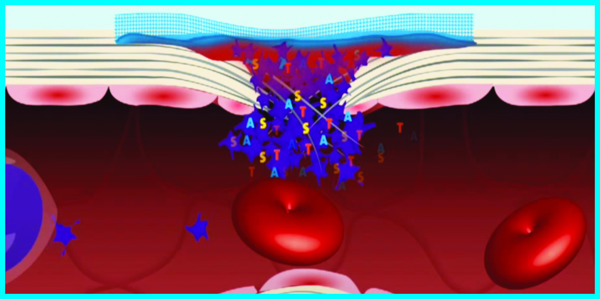
AHA stops bleeding by forming a physical barrier at the bleeding site and thus exerts a mechanical effect.
Negatively charged uronic acids in the ALGAN HEMOSTAT form a complex matrix with positively charged Ca++ ions coming from the plasma. The 3-dimensional structure of this formed complex matrix has porous cavities, into which blood cells, lipids, and protein molecules (osamine, etc.) are entrapped and consequently the plug formation begins at the bleeding site rapidly.
a. Cells and protein and other molecules (collagen, chondroitin 4,6-sulfate, elastin, hyaluronic acid) coming from blood also begin to accumulate within this forming 3-dimensional matrix by both electrostatic forces and physical entrapment.
b. Other interactive forces including hydrophobic interactions and dipole-dipole interactions also come into play. These interactions ensure that molecules with the same charge repel each other in the matrix and eventually form an equilibrium to remain steady thereafter. Consequently, the gaps within the matrix are further filled in as a result of the accumulation of blood constituents.
c. As the pores within the matrix are filled in with blood contents, the blood ow cannot pass through this barrier and no plasma leakage occurs. Eventually, the damage in the vessel is closed via the physical and mechanical properties of the 3-dimensional membrane barrier.
RESULT: UPON CESSATION OF BLEEDING, THE BODY'S OWN DYNAMICS BEGIN TO REPAIR DAMAGED VESSEL SITES BY REMODELING THE NEWLY FORMED MATRIX TO STRENGTHEN THE TISSUE INTEGRITY OF THE VESSEL AT THE INJURED SITE.

In the 3-dimesional structure of the formed complex matrix has porous cavities, into which blood cells, lipids and proteic molecules (osamine, etc.) begin to accumulate and the plug formation initiates at the bleeding site rapidly.

a. Cells and proteins coming from blood accumulates in the newly formed 3D matrix, which is formed as a consequence of both electrostatical interactions and physical entrapment.

b. Other interactive forces including hydrophobic interactions and dipole-dipole interactions come into play. These interactions ensure that molecules with the same charge repel each other in the matrix and eventually form an equilibrium to remain steady thereafter. Consequently, the gaps within the matrix are further filled in as a result of the accumulation of blood constituents.
c. As the pores within the matrix are filled in with blood contents, the blood flow cannot pass through this barrier and no plasma leakage occurs. Eventually, the damage in the vessel is closed via the physical and mechanical properties of the 3-dimensional membrane barrier.
RESULT: UPON CESSATION OF BLEEDING, THE BODY’S OWN DYNAMICS BEGIN TO REPAIR FURTHER THE DAMAGED VESSEL SITES BY REMODELING THE FORMED MATRIX TO STRENGTHEN THE TISSUE INTEGRITY OF THE VESSEL AT THE INJURED SITE.